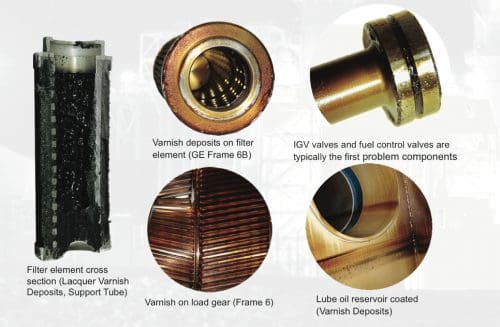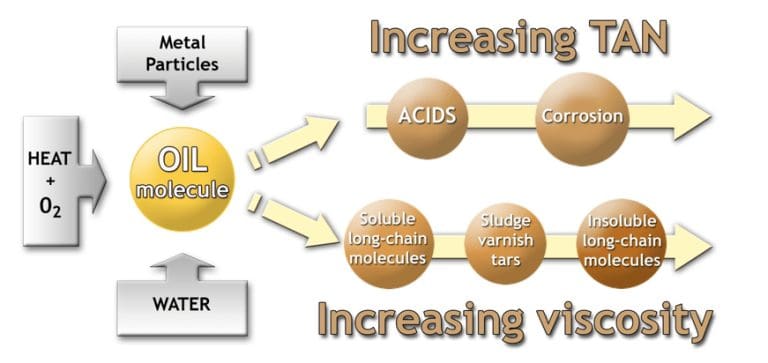Varnish
Varnish and Sludge, the hidden oil pollutants.
There are numerous types of insoluble contaminants found in hydraulic and lubricating systems.
Varnish and sludge comprise the various oil degradation by-products and soft pollutants.
It is a thin, insoluble film, consisting of long-chain molecules, that, over time, deposits throughout the internal surfaces of a lubrication system. The degradation process accelerates as the lubricant continues exposure to air, water, catalyst (metal particles), and high temperatures.
The fact is that varnish & sludge are present in virtually every hydraulic and lubricating system.
Sludge contamination is, without a doubt, the least recognized regarding hydraulic equipment contamination.
Since varnish is a soft pollutant, it is not measured during oil analysis. Most operators need to be made aware of their presence in the oil.
Find out about our new V100 varnish removing filter element!

Varnish will reduce the life of hydraulic machinery significantly.
That’s a fact.
TRIPLE R filter elements have been engineered to remove all contaminants, but without a doubt, it’s most impressive characteristic is it’s ability to remove varnish and sludge.
TRIPLE R’s performance is due to the combination of a particular filter media, the 3-stage setup of the filter element and the 114mm thickness of the filter. This combo allows TRIPLE R filter elements to achieve an unequaled level of oil purification.
Additionally, TRIPLE R filter systems are very flexible. They can be used in various combinations because all filter elements are interchangeable and can be used in every filter series, like BU-, TR-, SE- or OSCA-series. Just perfect.
For a cost of 25 € ~ 90 €, any TRIPLE R element can eliminate all contaminants from any hydraulic machinery with a tank volume of up to 1.000 liters. That makes TRIPLE R the cheapest offering for removing sludge and varnish, solids and water, and 3-in-1 oil purification instead of traditional oil filtration.
Varnish presence has far-reaching consequences.
Increased wear rates
Varnish captures hard contaminants, creating an abrasive surface that accelerates wear.
Heat exchangers become less efficient
Varnish & Sludge deposit adhere to the inside of pipework, thus forming an insulating layer decreasing the cooling effect of heat exchangers. This reduces the efficiency of the heat exchange and results in higher operating temperatures. Again this leads to increased power consumption and to faster oxidation of the oil.
The main line filters get blocked
Varnish is sticky, resinous substance, and it therefore stays behind in the pores of filters, quickly blocking them. This may lead to decrease in the flow rate and/or a higher P, and as a result the drive will operate more slowly. It becomes increasingly difficult for the pump to circulate the oil, leading to cavitation, higher power consumption and increased wear and tear. The main line filters need to be replaced more frequently.
Valves clog or operate badly
The presence of sticky resins increases friction to 5-6 times higher than nominal value. This will result in higher energy requirements and can cause stuck or seized valves.
Reduced clearance zones affecting lubrication
Often, this means a transition from full film to boundary lubrication, resulting in increased wear in pumps, bearings, gears and valves.
System corrosion and accelerated degradation due to acidic constituents
Varnish compounds are typically acidic and corrode metal surfaces.
Increased maintenance
Resources and costs required to clean varnished systems.

Contact Us for Comprehensive Solutions
Experience our top-notch filtration and oil cleaning solutions designed to meet your specific needs. Our dedicated team is ready to assist you with any inquiries, technical support, or scheduling consultations.
